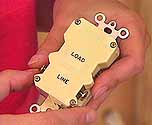So, for your protection, it is a good thing to have grounded outlets where ever you use anything that comes with the ground prong.
Older wiring didn't have the ground.. as the years went by, standards changed, and while it is not usually required to upgrade your house, it is still a good idea. As with all wiring, make sure you are only working on dead, de-energized circuits. Check with your local building inspector to determine if any permits are required or inspections.
Well, perhaps the best way, if access allows, new wire can be run that has a ground. At the entrance box (where your fuses or breakers are), the ground wire will attach to the grounding bar, which in many cases is the same as, or connected to, the neutral bar. Then, in your outlets, the ground wire can be attached to the green ground screw of the new grounded receptacles.
 Perhaps one of the cheapest and simplest ways to address this is by using a ground fault interrupter or GFI also known as a GFCI outlet. This is a good choice for many hard to re-wire cases. Instead of running a ground wire, or connecting a ground connection to the outlet, you will rely on the GFI function to provide the personal protection. It is not the same thing, but for most instances it is better. A GFI breaker or outlet will trip when there is not the same amount of current flowing in both electrical lines. So, if there is a loose wire, and some of the current starts to travel into the casing (toward you), it will trip and stop all current flow. Better than just letting it travel to the ground via the ground wire, it stops all current flow preventing any shocks. The one instance where it should not be used, is where equipment uses a surge protector (like your computer's surge protector if you have one). Surge protectors use the ground wire to redirect the surge until it can trip.
Perhaps one of the cheapest and simplest ways to address this is by using a ground fault interrupter or GFI also known as a GFCI outlet. This is a good choice for many hard to re-wire cases. Instead of running a ground wire, or connecting a ground connection to the outlet, you will rely on the GFI function to provide the personal protection. It is not the same thing, but for most instances it is better. A GFI breaker or outlet will trip when there is not the same amount of current flowing in both electrical lines. So, if there is a loose wire, and some of the current starts to travel into the casing (toward you), it will trip and stop all current flow. Better than just letting it travel to the ground via the ground wire, it stops all current flow preventing any shocks. The one instance where it should not be used, is where equipment uses a surge protector (like your computer's surge protector if you have one). Surge protectors use the ground wire to redirect the surge until it can trip.
 So, to use a GFI outlet, wire it in WITHOUT connecting anything to the ground screw. This outlet should be labeled "NO EQUIPMENT GROUND" since it has the ground connection left unconnected. Other outlets can be wired with standard grounded outlets if they are wired through the LOAD side of the GFI outlet. Still, running no ground.. these outlet should be labeled "GFI PROTECTED, NO EQUIPMENT GROUND"
So, to use a GFI outlet, wire it in WITHOUT connecting anything to the ground screw. This outlet should be labeled "NO EQUIPMENT GROUND" since it has the ground connection left unconnected. Other outlets can be wired with standard grounded outlets if they are wired through the LOAD side of the GFI outlet. Still, running no ground.. these outlet should be labeled "GFI PROTECTED, NO EQUIPMENT GROUND"



